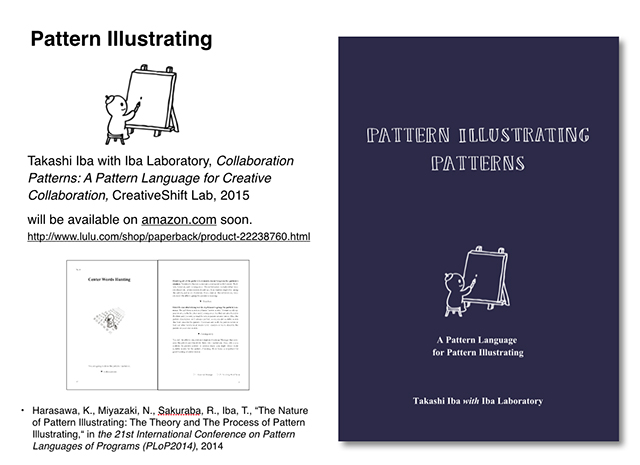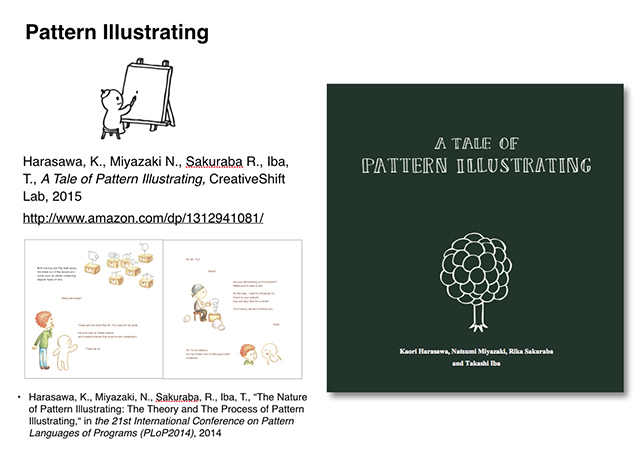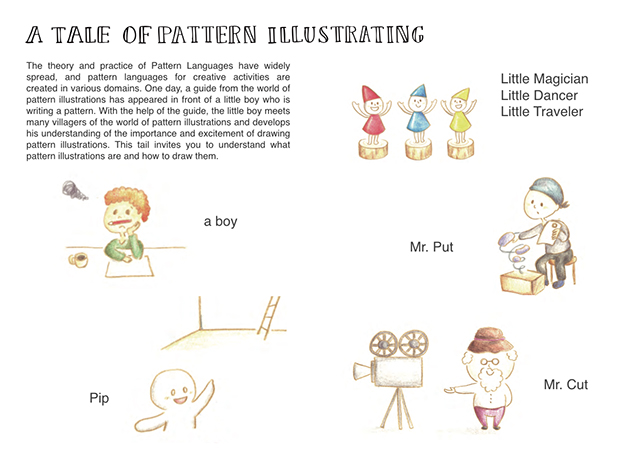
今年度春学期に開講した「パターンランゲージ」では、パターンを象徴的に表現するイラストの作成方法についてまとめた「Pattern Illustrating Patterns」を配布し、履修者のプロジェクトの支援を行った。本プロジェクトでは、この授業で使用した教材を英語で作成・整備した。
Pattern Illustrating Patterns are patterns for how to draw pattern illustration. A good pattern illustration helps readers understand and memorize the pattern and also motivates them to use it.
This book contains 28 patterns for pattern illustrating. It begins with pattern No. 0, Pattern Illustrating, that introduces pattern illustration, and three patterns, No. 1 Essential Message, No. 2 Moving Characters, and No. 3 Symbolic Representation, follow to define it specifically.
Then, the main three phases, “drawing elements” (Nos. 4–9), “determining the scene and space” (Nos. 10–15), and “finishing touches to raise the quality” (Nos. 16–21) are each supported with six patterns.
The last set of patterns concludes with “assisting when you are stuck,” which includes No. 22 Intriguing Doodles, No. 23 External Inspirations, and No. 24 Third Person View (“things you should care about in daily life”), No. 25 Polishing Word Sense, No. 26 Stock of Expressions, and No. 27 Improving by Drawing—all adding up to 28 patterns.
Please keep in mind that these patterns assist you with drawing pattern illustration, but do not tell you exactly and precisely what to do. These patterns introduce solutions to problems you are likely to face while drawing. By combining these patterns according to your needs, you should be able to produce good pattern illustrations.

The patterns in this book are all written in the same format. From the top left of the page: pattern number, pattern name, and pattern illustration. The top left expresses pattern number, and next is pattern name. The name gives the pattern a short, memorable name that describes the pattern, so that it can be easily referenced. Pattern illustration serves to help readers get a lively image of the pattern. From the bottom left to the right of the page: Context, Problem, Forces, Solution, Actions, and Consequences.
First, the Context or the situation in which this pattern should be used is described. Followed by that, a Problem likely to occur is written. The Forces underneath the Problem are unavoidable laws of human nature that make the problem difficult to overcome.
Then come the word “Therefore” and the Solution in bold type. Actions are better for explaining rather abstract solutions, using concrete Actions that readers can take. The Consequence describes how things should change when this pattern is properly applied to drawing pattern illustration. And lastly, Related Patterns are introduced.



